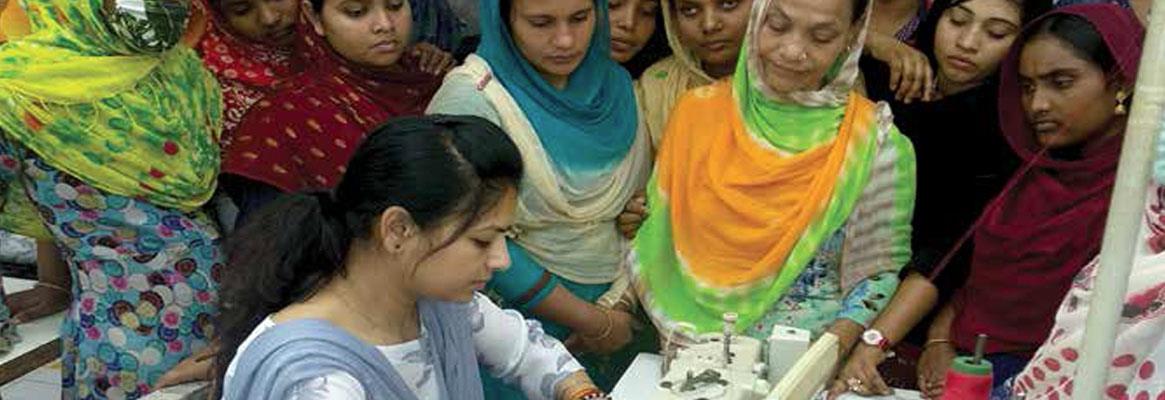An innovative skills development programme, supported by multiple agencies and the Bangladesh government, is making a crucial difference on the ground. It is boosting productivity and efficiency and improving the lives of garment workers at the same time.
The second largest apparel exporter to the world, the Bangladesh apparel industry is taking several initiatives to overcome some of the hiccups experienced in 2019 in terms of slowing of growth in exports and a few factory closures. As the industry aims to capture larger share of the international market, one of the challenges that needs to be addressed is shortage of the skilled workforce.
While the country has sizable population that is coming to urban centres like Dhaka and Chittagong seeking employment, these people lack specific skills related to the garment industry. They also have several other employment options available to them like construction sector, growing retail sector, etc.
Increase in Minimum Wages
In the initial growth phase, the Bangladesh garment industry benefitted significantly from the low wages and duty-free access to European Union (EU). However, during the last six years the wages have been increasing steadily as a result of an increase in the cost of living. The new minimum wage announced by the government of Bangladesh last year has come as a major relief for workers. It should be noted that the wages have also been increasing in all the competitor countries including Cambodia, Vietnam, China, Myanmar and India. But, Bangladesh continues to remain the major apparel producing country even though Ethiopia has the lowest wage bracket.
The garment factory owners have been demanding that the international buyers compensate for the increase in the minimum wage. While some buyers partly agree, they are of the viewpoint that factory owners need to focus on productivity improvement and strengthen their overall cost competitiveness. In accordance, much needs to be done across the supply chain and specially at the production floor level to eliminate inefficiencies, plug the holes and reduce wasteful activities. This has also created the need for improving the skills of human resources in the factories for supporting productivity improvement, managing reduced lead times, and controlling losses caused by the high rework levels.
Traditionally, garment factories used to recruit a lot of helpers as the wages were low. Now there is also an urgent need to train these helpers become value adding sewing machine operators.
Existing Approaches
Sewing machine operators constitutemajority of the workers in the garment industry. Traditionally, the industry depended on hiring experienced workers. But the supply of experienced workers cannot match the workforce demand of the industry growing at about 8-10 per cent per annum. Second, the salary expectations of the experienced workers are much higher.
 The existing skills training infrastructure in Bangladesh is not sufficient and, in most cases, not up to the mark. Some factories have also set up small dedicated training centres. The approaches used currently for operator training, barring exceptions, have the following limitations:
The existing skills training infrastructure in Bangladesh is not sufficient and, in most cases, not up to the mark. Some factories have also set up small dedicated training centres. The approaches used currently for operator training, barring exceptions, have the following limitations:
• High training time of about 30-60 days and high cost of training;
• Sub-optimal level of trainee performance at the time of completing training;
• Mismatch between expectations of supervisors and trainee skills;
• High trainee attrition rate during training and after reaching production floor.
The New Paradigm
In this background, thanks to Sudokkho project for the skill development and employment creation, international best practices in skills training have been ushered into the industry. The project is supported by UK Aid, Swiss Development Cooperation and Bangladesh government. It is implemented by Palladium International in association with British Council and Swisscontact.
Sudokkho's Industry-based Training (IBT) system has already been introduced in over 170 garment factories in Bangladesh by international training and consultancy service providers. The results have been very positive. Till January 2020, 773 infactory trainers have been trained, who in turn have trained 16,029 trainees to become sewing operators. In all, 1502 supervisors from the participating factories have also received training on technical as well as soft skills.
The project was initiated in partnership with international retailers like Debenhams, New Look, Primark, Mothercare and leading manufacturers Urmi Group and DBL Group. Recently, Marks and Spencer also joined the programme. The factories are using the system for training fresh trainees to become operators and training the existing helpers to become sewing machine operators.
The Results are There to See
The key results of the project are as under:
Reduction in training time: The average training time has substantially reduced from average 40 days to 20 days. This has helped the factories meet workforce demand quickly and trainees are able to start earning salary of operator grade faster. One of the trainees explained, "I feel proud to say now I am a skilled operator. I can contribute financially to my family as I am well paid. My family members and friends were astonished when they heard that I have become an operator within only 15 days."
Improved trainee performance: The production director of one of the participating factories was astonished to see that the new trainees started giving a higher output than experienced operators in a few weeks' time. The factories are also recognising the trainees and rewarding them.
Sharmin, a trainee trained under Sudokkho training system, was a helper when she joined the training. After being trained for 20 days, she was transferred to the floor as an operator. On the basis of her good performance and leadership qualities, the management promoted her as a line leader within a month. Currently, she is handling 25 operators. She said, "From being a helper to becoming the line leader within 18 months was not possible without getting the training from Sudokkho-RBC training system. I am confident that I will fulfil my dream as a line supervisor."

Reduction in cost of training: Most of the factories have been able to bring down the cost of training per trainee by over 25 per cent. The COO of one of the partner groups said, "Previously, we trained operators in 5-6 weeks but now it takes less than 3 weeks. This has reduced the cost of training."
Higher satisfaction among production management teams: The supervisors and production managers are highly satisfied with the trainee performance, attitude and discipline. An industrial engineer from a participating factory explained, "In our model line, the trainees themselves inspect their own pieces. We do not require helpers while other lines are using 4-6 helpers."
Productivity improvement of existing workers: The training system has also created the capability to improve the output of existing workers with a low output. This has resulted in an average improvement in the production capacity of the workers by 32 per cent across factories. This would certainly contribute to the productivity improvement of sewing lines.
Career progression opportunities for women: The project has also created career progression opportunities for operators, both women and men. Over 58 per cent of the trainers trained under the project are former female operators. They are now contributing to the industry through skill building, using international best practices. It has also provided them improved social status in the work life as well as personal life.
Lucky Akhter, a trainer, explained, "I met my trainee at a social ceremony, and she introduced me to her husband and neighbours and said - 'She is my trainer.' I am thankful to Sudokkho for the opportunity to become a trainer and live life with such pride and recognition." Many of the trainers trained under Sudokkho project have been promoted to the position of supervisors paving the way for further career progression opportunities.
On a Personal Note
The global consulting experience of the author shows that any garment factory with more than 300-400 sewing machines can set up an in-house skills training centre and run it costeffectively by utilising international best practices. Fortunately, programmes like Sudokkho make it possible for garment factories to access the international best practices and benefit from them. As the trainee performance is better, it helps the trainees earn better salaries in shorter time compared to traditional training techniques.
The author believes that the widespread evidence of the benefits of investing in the skills training, created by Sudokkho, will encourage more factories to create in-house training centres and train the workforce as per their needs. This will help jobseekers get trained faster and start supporting their families, thus contributing to poverty reduction. On the other hand, factories would benefit from the improved skills of the workforce, resultant productivity improvement and would be able to reward workers appropriately.



20240504122856.png)









Comments